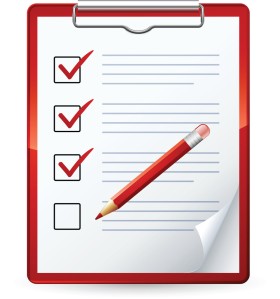A giant dent in your overhead guard is easy to spot at first sight, but what if there was a tiny leak from your propane valve? Would you be able to easily spot that? Chances are a busy operator could miss it. Planned maintenance isn’t the only thing that can be done to keep your equipment running in prime condition. In addition to planned maintenance, your operators should go through the daily operation checklist before each shift to ensure the piece of equipment is safe to operate.
Not only is it required by OHSHA, but a log will also help your operators be more aware and keep them accountable for how they treat the equipment, cutting down on misuse. If the lift needs a repair make sure you have the proper procedure in place.
- Tag the equipment inoperable (WARNING! DO NOT OPERATE!), make sure it is visible.
- Immediately notify the appropriate party.
- Keep the phone number of your repair service or person on the forklift.
- Log what needs repair, when the repair was made, and how much it cost to fix.
Tracking how often your forklift needs repair, as well as the cost, will keep you cognizant of your cost of ownership. If the machine is often out of service perhaps operators need further training operating the truck.
The greatest way a checklist will benefit your business and operators is safety. A truck should not be used when it is unsafe for operation. Forklifts are an investment in your company, and cost thousands of dollars; therefore a daily operator checklist is an easy way to prevent accidents and injury without spending money. Remember these machines literally weigh tons, with many moving parts, thus it is important to keep them in optimal condition.
The following is an example of a checklist OSHA suggests for your lift truck:
KEY OFF Procedures
- The vehicle inspection
- Overhead guard
- Hydraulic cylinders
- Mast assembly
- Lift chains and rollers
- Forks
- Tires
- LPG tank and locator pin
- LPG tank hose
- Gas gauge
- Check the engine oil level
- Examine the battery
- Inspect the hydraulic fluid level
- Check the engine coolant level
KEY ON Procedures
- Test the standard equipment
- Front, tail, and brake lights
- Fuel gauge (if diesel)
- Windshield wiper
- Heater
ENGINE RUNNING Procedures
- Check the gauges
- Oil pressure indicator lamp
- Ammeter indicator lamp
- Ammeter
- Hour Meter
- Water Temperature Gauge
- Test the standard equipment
- Steering
- Brakes
- Horn
- Safety seat (if equipped)
- Check the operation of load-handling attachments
- Check the transmission fluid level
Visit OSHA’s website for more information.
https://www.osha.gov/dte/library/pit/pit_checklist.html


